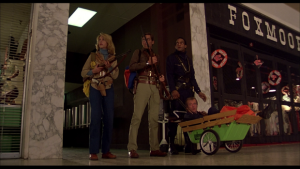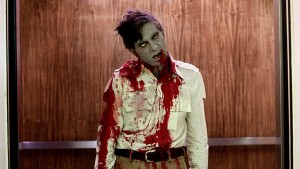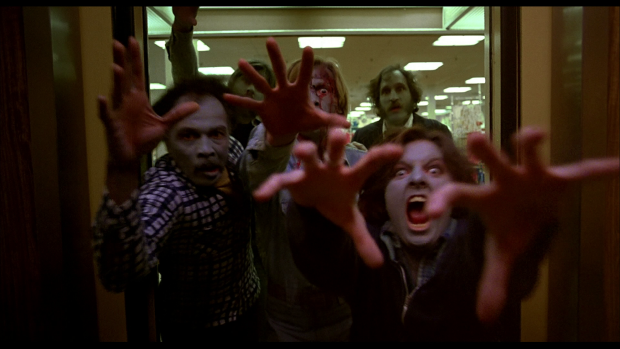Often considered the ne plus ultra of zombie cinema, George A. Romeros’ 1978 follow-up to his well-received “Night of the Living Dead” is about as far from its predecessor as you can get. In every way, “Dawn of the Dead” represents a vast departure from the mark “Night” made on the culture just a decade prior. And I’m not going to bury the lead here; “Dawn” is superior in every way to “Night.” It may also be the best movie Romero has ever directed.
Maybe picking up where “Night” left off, maybe not (continuity is not one of Romero’s major concerns throughout this series), SWAT team members Peter and Roger hook up with pilot Stephen and his TV producer girlfriend Francine and the quartet make their way out of Philadelphia in a news chopper and fly west. When they see a large mall with roof access, they stop to replenish supplies. Unfortunately for them, the mall is still filled with the living dead; drawn back to the temple of the consumer gods by some unknown instinct (“subtlety” can join its buddy “continuity” on the list of things that Romero can’t be bothered with). What is supposed to be a quick stop turns into a reverse siege: instead of trying to break in, our four heroes decide to occupy the mall, forcing the shambling dead out. Once they’re done fighting for their lives, the humans revel in the comfort and excess of the mall—until a band of bikers decide to bust in and all hell breaks loose.

In “Night” the social themes (youth movement vs. the establishment and racial commentary) were all subtext. Here, they’re just flatout text. The film begins in the middle of a zombie apocalypse with hell having already broken loose; and our first image is not of survivors scrambling for shelter or looting stores for supplies, it’s of a TV control room with people arguing about if they should broadcast old info or risk losing viewers. Romero is telling us out of the gate who the real mindless shambling masses are. At least the zombies have no choice but to roam around aimlessly without knowing why; they’re motorized instinct. But humans – living, breathing souls trying to survive? Romero knows the truth: when it hits the fan, most of us will be waiting for our masters in the box to tell us what to do or think next, oblivious to the fact that on the other side of that screen are people just as clueless as the rest of us.
Not satisfied with skewering just our media obsessed culture, Romero really goes for the jugular once our heroes hit the mall. To fully understand the impact of the setting, one has to remember that large indoor malls were relatively rare when this movie was released. They truly were the Karnaks of consumerism. Our relatively smart troupe doesn’t stay at the mall because it’s safe and easily fortifiable. Sure they may say that, but their actions belie their real motivations. They are entranced by the concept of having everything they could ever want at their fingertips. At the beginning of their mall adventure they’re happy to even have Spam to eat; an hour later in the film they’re having candle-lit meals and wearing garish fur coats indoors. In the face of oblivion, they must have only the finest. But even with the trappings of conspicuous consumption draped all over their bodies, it’s clear that they feel less satisfied after they’ve “liberated” the mall for themselves. As a famous action movie villain might say a decade later, they looked over their kingdom and wept, for there were no more lands left to conquer. Again, Romero is pulling no punches with his assessment of humanity: we break our backs for material possessions that don’t even fulfill us in the end.
 Even with his shadow looming large over the production, Romero is far from the only star behind the camera here. FX icon Tom Savini throws himself a coming out party, and the piñatas are exploding zombie heads. The visual effects aren’t particularly realistic. Everything from the violence to the color palette is over-the-top; more comic book than horror film. But they fit the tone and feature some of the most imaginative and exaggerated gore this side of the Grand-Guignol.
Even with his shadow looming large over the production, Romero is far from the only star behind the camera here. FX icon Tom Savini throws himself a coming out party, and the piñatas are exploding zombie heads. The visual effects aren’t particularly realistic. Everything from the violence to the color palette is over-the-top; more comic book than horror film. But they fit the tone and feature some of the most imaginative and exaggerated gore this side of the Grand-Guignol.
Accompanying the unique visuals is an outstanding score by the legendary Italian prog rock band Goblin. Having already made their mark composing for Italian director Dario Argento (who acted as producer and European distributor for “Dawn”), Goblin’s moody contributions vacillate from Spector-esque walls of sound, to paranoia inducing, sparse melodies. And yet, it all works and gives the film a unique energy in almost every frame.
There may be zombie movies with better acting, bigger stars, more realistic gore, and higher stakes; but one would be hard pressed to find one that is so much more than the sum of its parts. Not only is “Dawn” a fun zombie killing adventure, it’s also the first time a filmmaker used the zombie subgenre to directly confront the audience with the question of if zombies are really all that different from the survivors who fight them. Well-trod ground in 2013, but unheard of in 1978. “Battle ye not monsters” was the domain of certified classics like “Dracula,” and “Frankenstein” – films that were based off of legendary novels. Not either a gory sequel to an equally gory indie film, ”Night of the Living Dead” is the movie that introduced flesh eating zombies to horror films, but “Dawn of the Dead” is the reason they’re still around.
– by Jared Moore


